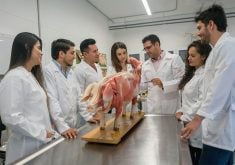Almost three years after the Romanow Commission recommended national action to improve rural health-care delivery, the situation has become worse instead of better, says a lobby group for rural doctors.
Since 2002, the number of physicians working in rural Canada has fallen by 155 while the total number of doctors in Canada has increased by 2,225, according to the Society of Rural Physicians of Canada, or SRPC.
“Provinces are failing to meet the needs of their most vulnerable populations, the rural patients, as the rural-urban gap increases,” said British Columbia physician and SRPC president Dr. Trina Larsen Soles.
Read Also

Fuel rebate rule change will affect taxes and AgriStability
The federal government recently announced updates to the fuel rebates that farmers have been receiving since 2019-20.
“Neither is the federal government fulfilling its duties in health human resources nationally. Divisive tensions and lack of political will are to blame,” she said in a statement.
At SRPC offices in Shawville, Que., office manager Lee Teperman said the problem lies at several levels – a lack of federal commitment, a lack of provincial implementation and the failure of many medical schools to prepare students to practise in rural areas.
“This is Canada, after all,” he said. “There are always divisions of responsibility. But we feel there does have to be a national rural health strategy and the federal government has to take the lead on that.”
In his 2002 report, former Saskatchewan premier Roy Romanow recommended creation of a $1.5 billion fund for rural and remote access. However, in the February 2003 federal-provincial health accord, the rural proposal was the only one of five short-term Romanow recommendations that was not acted upon, the SRPC complained.
Larsen Soles also took aim at medical schools that typically turn out city specialists.
“We need a socially responsible admissions system that draws from underserved populations and trains them in environments where they are most needed. To do this, both the federal and provincial governments have to work together,” she said.
The problems in rural medicine are not news to the government, said the MP responsible for rural issues.
Prince Edward Island Liberal MP Wayne Easter, parliamentary secretary to agriculture minister Andy Mitchell, said the issue has been debated at Liberal rural caucus, has been raised with health minister Ujjal Dosanjh and is raised by rural residents across the country when he has organized consultation sessions.
“Rural Canada is underdoctored. There is no doubt about it,” he said. “There are concerns about attracting doctors and that is exacerbated by the struggle to retain doctors once they settle in rural areas. It’s a huge problem and there are no clear answers.”
Easter said it shows a flaw in the $41 billion federal-provincial health deal.
“We are not demanding accountability (of the provinces) so the money goes out but we cannot ensure that it is addressing all the crucial issues,” he said.
“But I think it goes beyond numbers and dollars. Rural doctors worry about burnout, the lack of support staff, equipment and just the presence and support of other doctors.”
The federal government has announced it will move toward accepting the credentials of foreign professionals who immigrate to Canada, suggesting foreign-trained doctors could be part of the answer to staffing rural offices.
But Teperman from the SRPC and Easter agreed there are problems with the foreign doctor initiative.
Easter said he has an ethical concern about luring professionals from developing countries where they are needed.
Teperman called it poaching.














